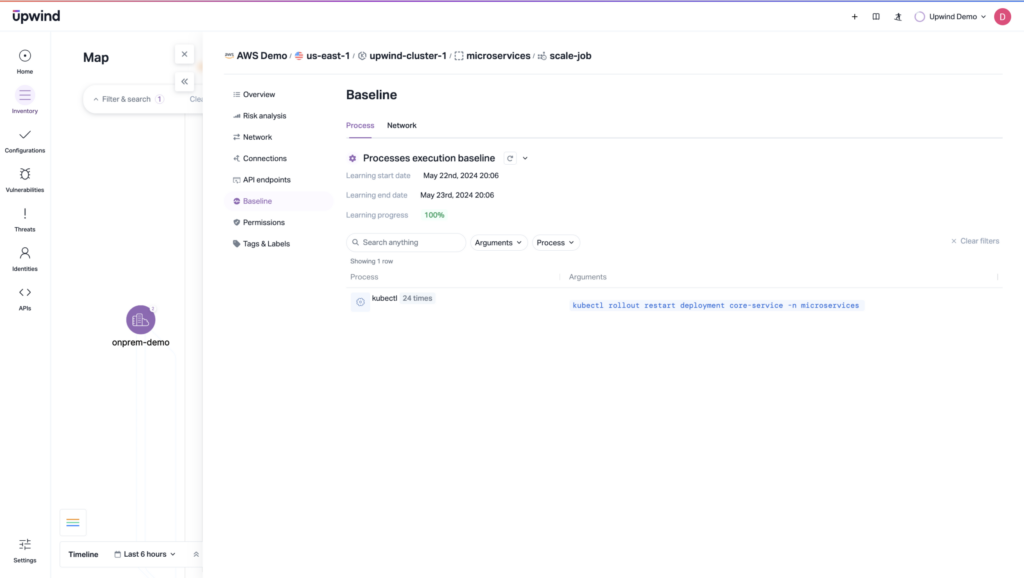
First, there were perimeters. The idea gradually gave way to endpoints, but today, identities are often the first point of entry to vast, diverse cloud systems. They’re enablers of lateral movement, pivot points in cloud and SaaS environments, that hold the keys to the rest of the environment. In other words, identities deserve attention. In this article, we’re explaining the fundamentals of Identity Threat Detection and Response (ITDR) and going deeper into architectural fit, post-implementation secondary challenges, and best practices.
Introduction to Identity Threat Detection and Response (ITDR)
The shifting of operations to the cloud has also shifted the frontier of security from networks and endpoints to identity and access.
Identity threat detection and response (ITDR) emerged as a framework only in the past few years. It was a response to an explosion of identity-based attacks, from SolarWinds to Okta and Uber, which showed that attackers could bypass endpoints entirely by abusing credentials, tokens, and federated access.
With Zero Trust models, identity was further cemented as the “new perimeter.”
According to Verizon’s Data Breach Investigations Report, in 2022, the vast majority of data breaches — 82% — involved compromised identities.
At the time, ITDR built on blind spots in existing tools. For example, Security Information and Event Management (SIEMs) and Endpoint Detection and Response (EDRs) could log authentication events but lacked identity-specific logic. And Identity and Access Management (IAM) systems controlled policy, but didn’t detect live attacks.
Ultimately, ITDR combined runtime detection and the response gap between IAM and traditional monitoring.
It is built on related tools, so let’s quickly differentiate what each brings to the table.
| Tool | What it Includes | Why ITDR is Needed |
| Security Information and Event Management (SIEM) | Aggregates logs and events. Enables rule-based alerting | Lacks identity-specific detection logic. Weak to correlate across federated identity systems in real-time |
| Privileged Access Management (PAM) | Manages vaults and rotates credentials. Enforces access policies | Doesn’t detect abuse after access is granted. Can’t see session hijacking or lateral movement via tokens |
| User and Entity Behavior Analytics (UEBA) | Baselines normal behavior and flags anomalies using machine learning (ML) | Can be siloed. Doesn’t specialize in cloud/service identities. Doesn’t specialize in real-time session misuse |
| Identity and Access Management (IAM) | Manages roles, entitlements, and access provisioning | Does not detect live threats or suspicious use of granted access |
| Extended Detection and Response (XDR) | Correlates data across endpoints, network, and cloud | Doesn’t always include identity context. Lacks deep identity-centric detection or federated identity traversal tracking |
Identity-Aware Runtime Detection with Upwind
Upwind brings identity context into runtime and container scanning, detecting threats tied to IAM roles, service accounts, and privilege misuse in real time. It correlates cloud identity activity with workload behavior to surface risks faster and with more context than traditional scanning tools.
The Importance of ITDR in Modern Cybersecurity
According to researchers at IBM, identity-based attacks have proliferated due to both the acceleration of AI technology that’s allowed for massive phishing expeditions and the gaps that come with more complex hybrid-cloud environments.
Neither of those is going away anytime soon, so the need for ITDR, which is purpose-built to defend against attempts to leverage stolen credentials for illicit access and privilege escalation, is here to stay, too. Such protections are vital to modern cyberdefense.
With ITDR, security teams can ensure proper functionality in their access policies and protection against lateral movement or unauthorized access of sensitive information. They get:
Anomalous identity behavior detection
ITDR detects anomalies, like geo-velocity, off-hours use, and service account abuse in real time.

Identity attack path analysis
ITDR maps how attackers pivot using over-permissioned identities, chaining roles and services to access new, sensitive areas.

Session and token abuse detection
ITDR identifies hijacked sessions, reused tokens, and unauthorized API use even when attackers don’t deploy malware or compromise an endpoint.
Across-platform identity correlation
ITDR unifies identity access across cloud, SaaS, IAM, and on-prem. That means it’s able to identify federated or multi-hop threats.
Automated, identity-aware events
ITDR triggers actions like MFA enforcement, account suspension, or SOAR workflows in response to live identity threats.

Behavioral baselines and risk scoring
ITDR profiles normal activity on both human and service accounts. It can prioritize high-risk accounts for investigation.

Common Threat Scenarios Addressed by ITDR
Those capabilities don’t exist in a vacuum. They were built to address increasingly common threats. And ITDR is still an ideal tool for teams coping with these common threat scenarios:
- Credential misuse: ITDR can identify when threat actors attempt to use stolen identities to access unauthorized data.
- Account or device takeover: These are attacks that occur when threat actors try to compromise authorized accounts or take over non-human entities like IoT devices to use as part of their attack chain.
- Privilege escalation: One of the core threats that ITDR protects against, the solution can detect when misconfigurations are applied to elevate the privileges of compromised accounts with the goal of accessing sensitive data.
- Malicious API calls: Attackers can compromise APIs to steal credentials or exfiltrate data to an unauthorized location. ITDR can detect this activity and interrupt the attack.
- Insider threats: Protecting against malicious insiders accessing sensitive data or technologies is another key threat that ITDR protects against.
ITDR is still key, even with a CNAPP. CNAPPs give teams identity-contextual insights, but they aren’t comprehensive across identity-layer detection, monitoring things like SaaS behavior, session hijacking, or correlations across federated Single Sign-On (SSO) events. It’s the identity-aware detection layer that a CNAPP won’t fully replace. To cover the full lifecycle of cloud-native identity and runtime threats, you’ll need both.
Features of an Effective ITDR Solution
When looking for an ITDR solution, organizations should assess their specific use case. Prioritize an ITDR along with your CNAPP when:
- Identity is the primary attack surface
- You want end-to-end threat coverage from authentication to action
- You manage multi-cloud, SaaS, and hybrid identities
- You experience credential abuse, insider threats, and session hijacking
Depending on the capabilities of the existing security stack, here are several features that security teams will also want to prioritize:
- Continuous monitoring: ITDR systems provide persistent, real-time threat visibility into identity activity, including logins, but also how identities interact with cloud assets, SaaS, apps, and workloads over time. Unlike periodic scans, ITDR often taps directly into identity providers, cloud control planes, and session telemetry.
Look for solutions that offer always-on visibility across IdPs, cloud accounts, and service identities, not just log event aggregation.
- Behavioral analytics: These tools apply machine learning not only to human behavior, like login times and access patterns, but also to non-human behaviors like service accounts using automation tokens. This broader behavioral scope is key for detecting silent misuse in Infrastructure as Code (IaC) environments or CI/CD pipelines where service identities can operate unchecked.
Seek out solutions that distinguish between human and machine identity baselines and highlight changes in behavior across both.
- Anomaly detection: ITDR tools focus on anomaly detection in identity-contextual ways, like impossible travel across IdPs and unusual SSO login flows. They can factor in entitlement context, like what the identity should be doing, to reduce false positives and better model risk escalation paths.
What makes it work? Find tools that correlate behavioral anomalies with the IAM context, not just activity logs.
- Automatic threat detection: ITDR builds identity threat models, going beyond the traditional rule or signature-based detection models. Is an account acting like a hijacked user? Is a service account exhibiting lateral movement behavior? ITDR detects misuse even when it doesn’t match a previously-known pattern, which SIEM and XDR platforms won’t catch without tuning.
Look for platforms with identity-specific threat modeling and scoring beyond traditional Indicators of Compromise (IOC)-based detection.
- Automated incident response: The value of ITDR is that it acts within the identity plane. It can trigger enforcement through IAM, like enforcing MFA or disabling roles. That makes it more versatile and useful than traditional SOAR playbooks when it comes to detecting identity-based issues. It’s especially key for stopping live session hijacking or containing a compromised account quickly, before it can move laterally.
The goal? Find a tool that integrates with your specific IAM and IdP systems to enable identity-specific containment actions.
- Integration with Existing Security Infrastructure: To be truly effective, ITDR must be integrated with existing security tooling. ITDR is most often used in conjunction with security information and event management (SIEM) solutions, EDR, and privileged access management (PAM) tools.
Look for these integrations in addition to IAM and IdP integrations for a holistic approach.
- Scalability and Vendor Considerations: Not all ITDR tools handle scale in the same way. Some struggle ingesting high-volume identity telemetry from thousands of users, while others rely on batch processing or delayed enrichment, which can undermine real-time detection.
Look for ITDR platforms that offer near-real-time detection at scale, can ingest millions of identity events per day, and maintain performance across multiple identity sources like Okta, AWS IAM, and Azure AD.
Implementing ITDR in Your Organization
ITDR is a control plane extension for modern, identity-centric security. Successful implementation means deeply embedding it into the detection pipeline, not just adding it as a standalone alert engine. Below are key technical and operational practices that guide high-fidelity deployment.
- Map your identity graph in addition to IAM policies: Before choosing tools, map how both human and non-human identities traverse the environment: where they authenticate, what they access, and how they’re federated across cloud and SaaS. Include IAM and SSO settings, but also CI/CD tokens, workload identities, and service accounts. Prioritize tools that can observe all these paths in real-time.
- Validate native integration with IdPs, cloud APIs, and runtime context: ITDR is best when it connects with multiple, reliable data sources. Find and implement a platform that ingests and correlates signals from key platforms without relying on brittle log forwarding and scheduled syncs. Native API integration and support for ephemeral session and token telemetry are key.
- Let the system learn, but monitor signal quality: Baseline building is an ongoing process. ITDR should passively monitor for a few weeks to learn typical identity behavior, and so teams can validate the signal-to-noise ratio early. Large numbers of false positives can mean the platform lacks context, not merely tuning. Test behavior detections using edge cases, but also revisit baselines beyond the initial implementation phase.
- Surface identity threats in the same plane as other alerts: Don’t bury identity threats in a separate console, but make sure they’re implemented within SIEM, CNAPP, or XDR to maintain context. Set up a unified threat view with rich data that includes identities, privilege levels, and access paths.
- Automate containment but gate by risk scoring: Automated playbooks should lock accounts, revoke privileges, or isolate sessions. But they should do so only when risks are high. Tie automate triggers to behavioral scores to avoid frustrating breaks in legitimate workflows. Integrate ITDR with IAM/PAM for just-in-time controls and set-up auth without just defaulting to locking down accounts.
Secure Identities at Runtime with Upwind
Upwind strengthens identity protection by tying identity context directly to real-time runtime behavior, so teams can detect and respond to anomalous access across workloads, cloud APIs, and IAM roles. Upwind’s identity-aware insights, like privilege misuse and anomalous role activity, offer foundational identity security to manage cloud-native threats and get insight into runtime privilege escalation.
To see how Upwind bridges the identity and runtime gap, schedule a demo today.







